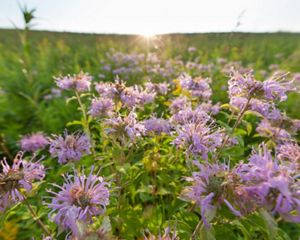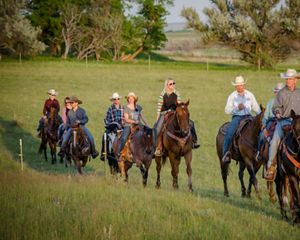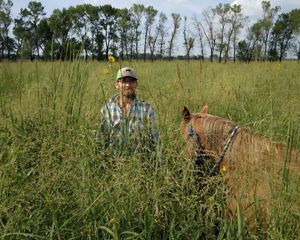What’s in this Season?
North Dakota’s ever-changing seasons serve up immeasurable discoveries in nature. Explore what’s happening in nature this season.

Winter

Winter in North Dakota is cold and snowy, but that should not keep you from exploring the outdoors! The trails are quiet and chances are, you may be the only one braving the elements. Embrace the solitude and soak in the mental health benefits the snowy plains and icy ponds have to offer. Bundle up and grab your snowshoes. There is so much going on in nature even on the chilliest days.
Birds
Winter is the best time for birding because there are no leaves on the trees. It makes spotting birds much easier. Although many birds flee North Dakota during the cold winter months, we have some year-round resident birds that you can surely spot around the state, like American Goldfinch, woodpeckers and blue jays. You could even see a Northern shrike, which visits the Dakotas in the winter, returning to northern Canada to nest in the summer. These birds are fierce hunters. Shrikes attack and kill a variety of prey: other birds, mice, lizards, insects; at times even tackling prey larger than themselves (a shrike is about the size of a robin).
They kill using their hooked beak; their feet are too weak to kill with grasping talons like hawks and owls. A shrike might not eat its prey immediately. Instead, the bird carries its prey to a larder where it will store food items impaled on barbed wire, thorns, broken twigs, or simply wedged into the fork of two branches. Sighting a shrike could be difficult. In the winter, you might first find evidence of shrike predation—dead sparrows or mice skewered on thorns or barbed wire—before spotting a shrike hunting nearby.
Winter Birds
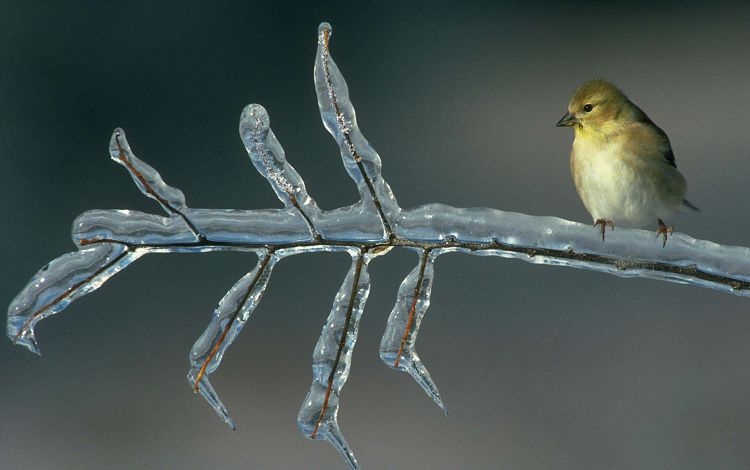
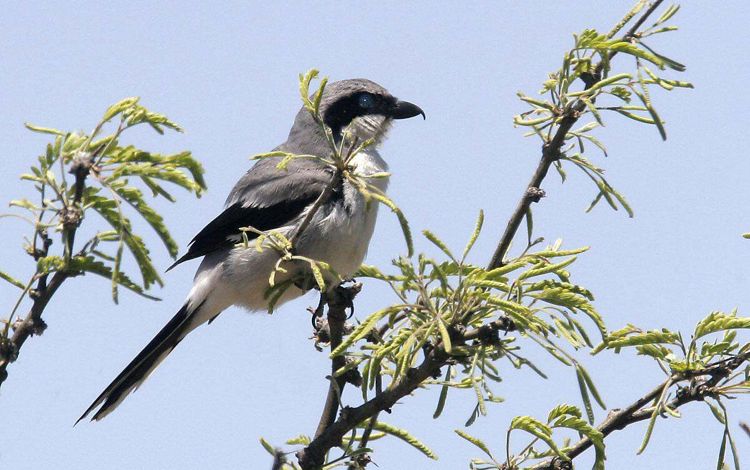
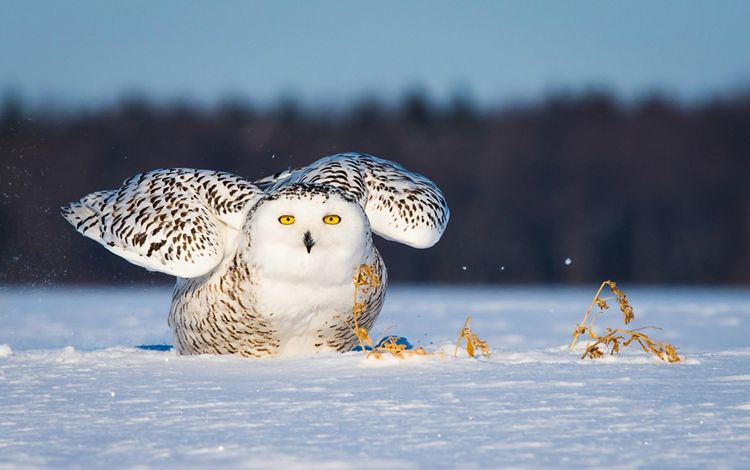

Occasionally, North Dakota sees snowy owls, visiting all the way from Alaska, Arctic Canada and Greenland. Their plumage reflects their northern home: the birds are white as snow, although females and young birds are barred with black. Their face is always bright white and highlights their brilliant yellow eyes.
Bison
Much of North Dakota’s wildlife either migrates or hibernates to escape the harsh winter. But bison seem to thrive in the cold. They’re animals built for life on the prairie year-round. Visitors to parks and preserves with bison herds enjoy watching bulls, cows and calves mingling together during the summer months. Come late fall, the bulls wander off to form “bachelor bands” and the cows, calves and non-breeding bulls stay together in small herds. These dispersed, separate groups make for fewer animals looking for food in the same place once winter snows make forage hard to find. It’s a good survival strategy.
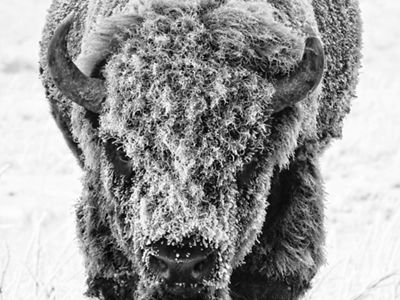
Bison eat less in the winter. Their metabolism actually slows, allowing them to survive on less forage. Using powerful neck muscles, bison swing their massive heads to push snow out of their way to reach forage beneath. Bison also are good at staying warm. Their summer coat turns dark brown in the fall and develops a dense undercoat of woolly hair that provides insulation during cold weather.
Guard hairs provide added protection and are longest on the front half of a bison’s body, covering the head, neck, forelimbs and tall hump above the shoulders. The winter coat on a bull bison can be as much as six inches thick over the hump. During a storm, bison turn and face into the wind, causing these long hairs to lie down against the body, maximizing their insulating ability. Their winter coat insulates so well that a storm’s snow simply accumulates on the animals, unable to be melted by their body heat.
Wildlife Detective
Winter’s snows provide the perfect chance to flex and grow your wildlife tracking skills. From the common hoofprints of white-tailed deer to the distinct paw prints of coyotes, you never know whose tracks you’ll spot in the snow throughout TNC's preserves.


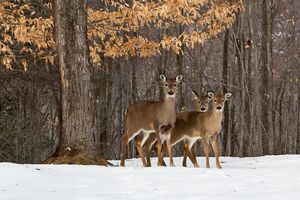

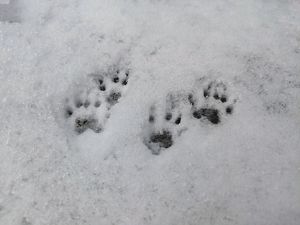

Coyote Pawprint: Coyote pawprints are a common sight in the snow. © Charles Larry

Coyote: Coyotes are present in many Illinois counties. © Lisa Bourgeault /TNC Photo Contest 2019

White-tailed Deer: White-tailed deer can be spotted across the state. © Kent Mason

Red Fox Tracks: Winter is an ideal time to practice identifying wildlife tracks thanks to how well snow can hold prints. © James Day/TNC Photo Contest 2022

Racoon Tracks: Snowfall makes for excellent opportunities to practice your animal track ID skills! © Lily Mullock/TNC
Places to visit
There is no shortage of places to experience the natural world in a North Dakota winter, but here are some of our recommendations.
Cross Ranch State Park: Located along the only free-flowing section of the Missouri River in North Dakota, the state park has nearly 17 miles of hiking trails that can be explored on cross country skis in the winter. Hop across the street to The Nature Conservancy’s Cross Ranch Preserve to catch a glimpse of the resident bison herd.
Lake Metigoshe State Park: Located near the Canadian border, Lake Metigoshe is a winter wonderland, getting you outdoors and enjoying nature through activities like cross-country skiing, snowshoeing, sledding, fat tire biking and ice fishing.
Devil’s Lake: Try your hand at ice fishing on Devil’s Lake. It’s a great way to get outdoors in the chilliest months. (Don’t worry – you can get a heated icehouse!)

Need More Nature?
Sign up for Nature News and start getting more of the news you want.
Spring

The signs of spring are always welcome after a long North Dakota winter. From early spring flowers popping up through the snow-crusted prairie to critters frantically seeking a mate, spring is a time for beauty and renewal. Enjoy the trickling waters of a slowly thawing river or lace up your boots for a tromp along a muddy trail. Take time to observe the hints of spring all around you.
Cuteness alert
Spring has sprung when cinnamon-colored baby bison appear on the prairie.
Most bison calves are born in May and June. Pregnant cows first chase off their offspring from the previous spring: yearlings that stay with the herd but can no longer rely on their mother’s care once a newborn arrives. Shortly before giving birth, a cow will move to the edge of the herd or leave the group altogether. The process takes only about 20 minutes and the calf can stand on its own after another half hour and run with the herd within one to three hours.
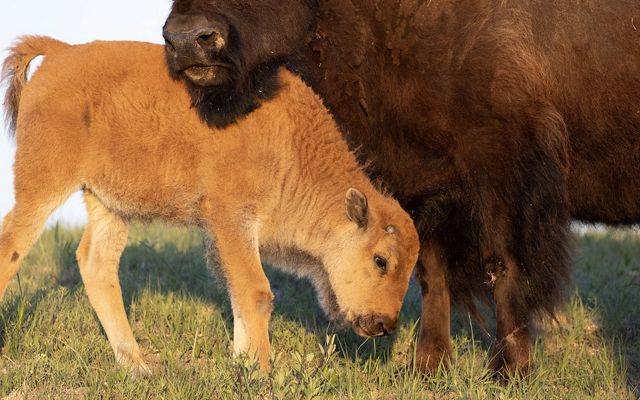

After their first few weeks, young bison become more adventurous and may wander away from their mothers to explore the herd. They often form nursery groups: two to three dozen calves that are tended by a few cows. This is a good time to watch the young animals—bison watchers can see them learn from their mothers, begin to graze and sort out who is dominant in their groups.
Early blooms
The pasque flower is one of the first flowers to bloom on North Dakota’s grasslands. You may even see it blooming out of the melting snow. Pasque flowers thrive on prairies with sandy soils, like TNC’s Pigeon Point Preserve. Nature writer Aldo Leopold wrote in A Sand County Almanac, “The chance to find a pasque flower is a right as inalienable as free speech.” Find a pasque flower and know unquestionably that spring has arrived on the prairie.
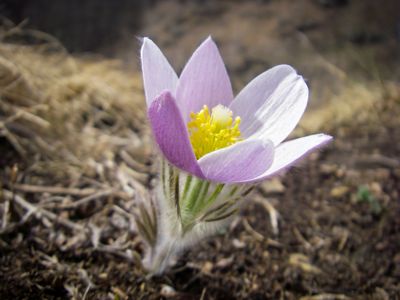
Spectacular courtship
The courting displays of sharp-tailed grouse are fascinating to watch in the spring. These chicken-like birds gather at a lek, a patch of ground where males compete for the attention of hens by performing a dance display at dawn. Dancing grouse spread their wings, lower their heads and raise the short, bright yellow feathers above their eyes.

The tail is raised and spread like a fan and the birds rush forward or turn in tight circles, rapidly stamping their feet and rattling their tail feathers. The males inflate and deflate prominent purple neck sacs, cooing and cackling. They also fight—within the lek, each bird has a small territory. These territories are hotly contested, as hens may prefer males in some locations over others.
Nesting season
Piping plovers nest in North Dakota in May. These shorebirds return from winter along the Gulf Coast in April and lay their eggs by mid-May. The nesting habitat they like best is secluded beaches with little vegetation along lake shores, and they find those ideal conditions by the alkali lakes at TNC's John E. Williams Preserve. Piping plovers have declined throughout their range and TNC has been actively managing the birds at the preserve to increase their numbers. During May, June and July, the beach areas at the preserve are closed to visitors to prevent disturbing the nesting birds.
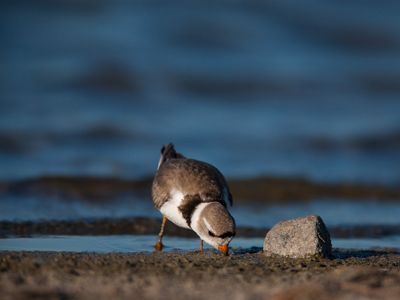
Places to visit
-

Theodore Roosevelt National Park
Catch a glimpse of newborn bison sprinkled throughout the herd at this national park. They’re easy to spot with a reddish coat that contrasts the dark brown color of older animals. Explore
-

Pigeon Point Preserve
Pasque flowers can be found blooming at this TNC preserve in April, an unquestionable sign of spring! Explore.
-

Pembina Gorge
This recreation area near the Manitoba border is home to 30 native plant species and 21 animal species categorized as rare in the state. Enjoy a hike, or if you’re feeling more adventurous, consider mountain biking or horseback riding. Explore
Summer

Summer: it’s what makes the North Dakota winter worth it.
Throughout the season, the state is abloom with wildflowers. Every few weeks a new suite of plants is opening delicate petals to the bees and butterflies seeking out nectar.
If you get out on a hike, whether short and sweet or long and challenging, you’ll see plenty of birds and other wildlife across the state. Everyone is out enjoying the warm weather!
Here’s what else you can discover in nature this summer in North Dakota.



Places to visit
-

Sheyenne National Grassland
This expansive prairie is home to the endangered western prairie fringed orchid. See if you can find it! Explore
-
John E. Williams Preserve
The preserve's alkaline lakes support a large breeding population of piping plovers. Contact TNC at 701-794-8741 to get permission and receive tips and guidelines before visiting the piping plover nesting site. Explore
-

Audubon National Wildlife Refuge
This 14,000-acre refuge attracts tons of migrating birds. Don’t forget your binoculars! Explore
Fall
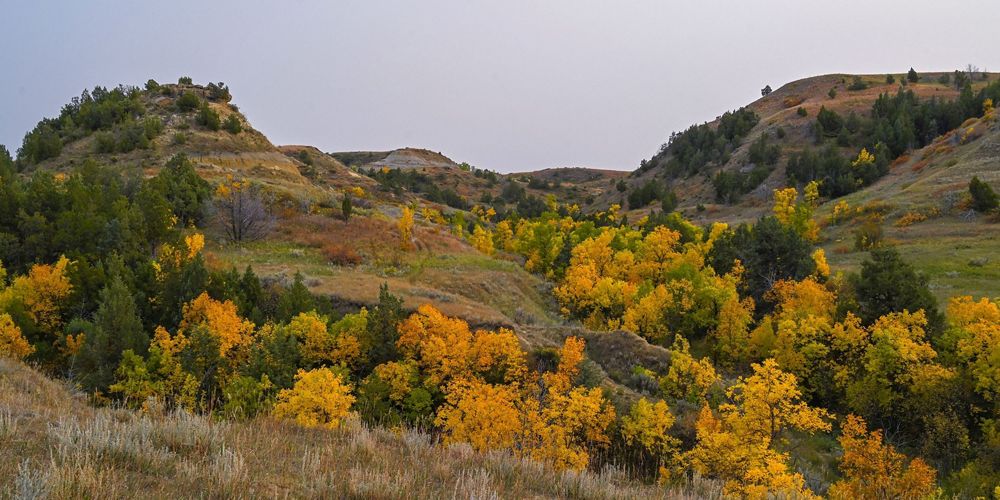
Autumn is a season of change in North Dakota. Migrating birds flee to warmer climates. Hoofed mammals shift into their breeding season, activating the “rut.” And North Dakota’s tree canopy turns from its summertime green to a kaleidoscope of yellow, red, orange and brown. Don’t hesitate to get outside and enjoy nature’s signs of change—this season won’t last long.
Fall Color
The spectacular fall colors arrive in North Dakota in late September and continue throughout October.
Many of those colors have been present in leaves during the entire growing season but masked by chlorophyll, the light-absorbing green pigment that is essential for photosynthesis. When the days shorten in the fall, photosynthesis slows and eventually ceases, causing deciduous trees to stop making chlorophyll and allowing other pigments in leaves to become visible. Carotenoids are the pigments responsible for yellows, oranges and browns; anthocyanins create reds and purples; and mixes of the two pigments result in bronzes and deeper shades of orange.
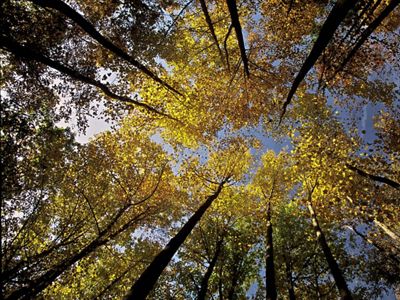
Location, weather and type of tree determine when this color change takes place. Cooler locations are where the transition begins, causing trees at higher elevations to change color first. However, timing can change from year to year, influenced by temperature and rainfall. Drought causes less brilliant colors and trees in dry years drop their leaves earlier. At any one location, tree species also determine fall color. Ashes are known for their early color change. Aspens, cottonwoods and maples often follow, and oaks change color later.
The Rut
Fall is the season of courtship for many mammals in North Dakota. Their offspring do best if born soon after winter has ended, when they have time to grow before the return of harsh weather. This fall breeding season for hoofed mammals is called the rut. This is the time of year when antlers and horns become essential—males use their headgear to compete for females and spectacular clashes can occur.

Pronghorn
The rut begins at different times in the fall for different animals. Pronghorn are among the first; their rut begins in mid-September and can last well into October.
Pronghorn have horns, which are different than antlers because they are not shed. Horns have a bony core that is covered with a nail-like sheath; in pronghorns, that sheath is formed by fused hair that grows to become the outermost tips of the horn. Both males and females have horns, but a female’s horns are much smaller.
The horns are mostly for show but can become weapons if two males are closely matched. Bucks establish territories in March, long before the rut begins. They select the best grazing lands that will attract many does—a harem that they will defend against other males in September. Usually, all that is needed is a snort, a stare, or a brief chase to discourage a potential rival. But animals of similar fitness may come to blows, clashing their horns until one leaves. Young males or old bucks past their prime are rarely able to claim a harem.

Bighorn sheep
In November, bighorn sheep undertake their rut. Bighorn sheep are among the last to breed and the competition between rams for ewes can make for spectacular wildlife watching.
Bighorn sheep horns grow incrementally year to year, and older rams can have an impressive pair. One record-setting ram had horns that were each more than 45 inches long and greater than 16 inches in circumference at their base. Ewes have horns too, but they are slender, and so short they do not extend for more than a half-circle.
Rams and ewes keep apart until fall: the rams in bachelor herds and the ewes with their lambs in larger nursery herds. By October, these two groups begin to intermingle and soon the rams are competing for mates. Smaller rams give way to the older males, but more evenly matched males do not yield without a fight. Battling males gradually approach each other until 30 or 40 feet apart when they simultaneously rear up on their hind legs then lunge forward to collide head-on. The loud crack of their smacking horns can be heard a mile away on a calm day. The dazed rams pause, recover, then repeat the charge. The contest can continue for hours, ending only when one of the rams yields.
Bighorn sheep once numbered 2 million across the western U.S., from Canada to Mexico. But overhunting, habitat loss and competition with livestock drove their numbers down to just 20,000. Today, bighorn sheep populations have rebounded to around 70,000—thanks to reintroduction efforts in national parks and beyond. These animals like to roam widely, so large, connected habitats are critical for the species’ survival.
Here in North Dakota, a few hundred bighorn sheep can be found in the steep badlands along the Little Missouri River, like in Theodore Roosevelt National Park.
Waterfowl Migration
Eastern North Dakota is covered in wetlands and dotted with small prairie ponds called potholes that were formed when glaciers covered this landscape. These freshwater habitats create a hotspot for migrating ducks, geese and other waterfowl.
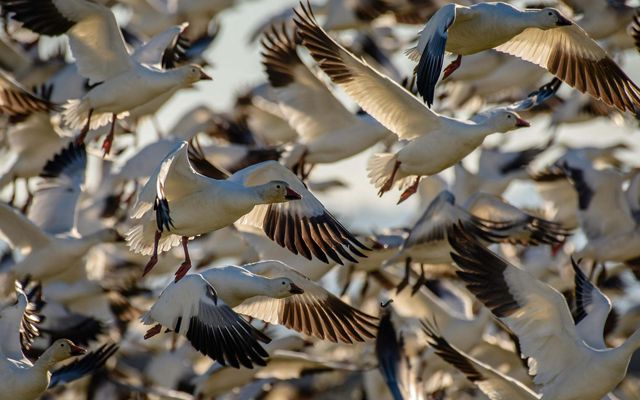
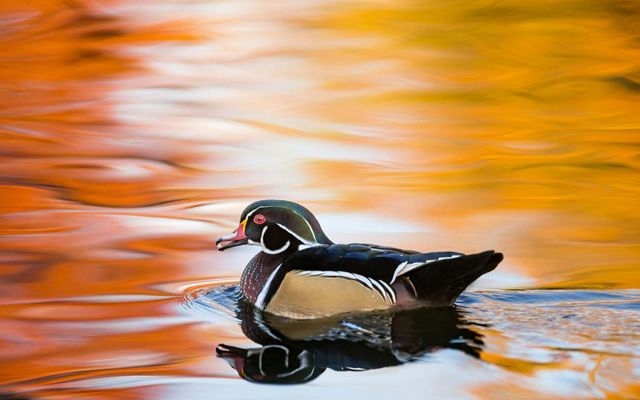
Ducks and geese are excellent subjects for beginning birders since they are often easily seen on open water, unlike small songbirds that can be hidden behind leaves. Most have distinctive field marks and behaviors that can be quickly recognized with practice.
Grab a field guide and binoculars and look for waterfowl at wetlands such as Lake Alice, Lostwood, or Des Lacs National Wildlife Refuges. A fall highlight is the thousands of snow geese that visit these and other refuges. Sandhill cranes are another impressive bird that migrates through the state in the fall. Listen for their bugling calls then look for their flocks flying past overhead.
Places to Visit
-

Theodore Roosevelt National Park
Spot pronghorn and bighorn sheep during the rut. Plus, this park is a great spot to observe North Dakota’s stunning fall colors. Explore
-

Lake Alice National Wildlife Refuge
Lake Alice in northern North Dakota is a hotspot for ducks and geese. Check it out in the fall to see migrating waterfowl. Parts of the refuge are also open to hunting and fishing. Explore.
-
Brown Ranch
This TNC preserve provides important wetland habitat to migrating waterfowl. Stop by to practice your bird watching skills! Explore


